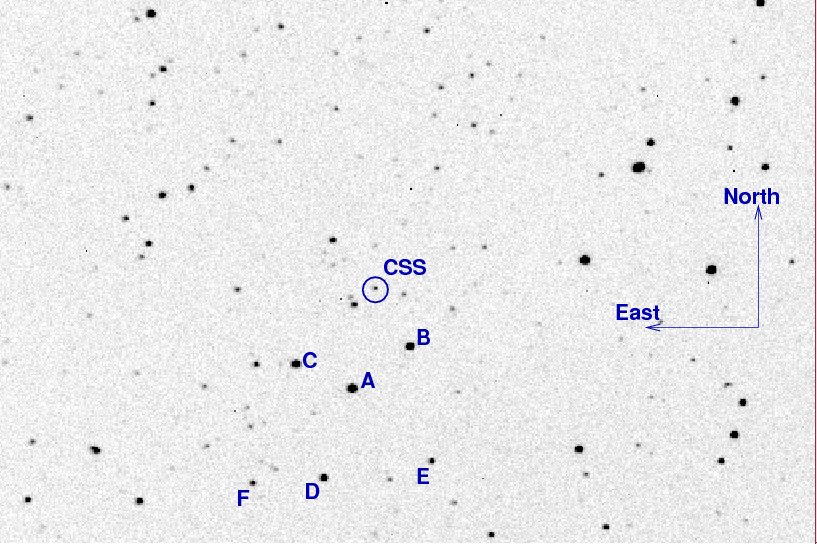
On the night of Aug 23/24, 2012, I observed the variable star CSS 203938-042908 , a cataclysmic variable star recently discovered by the Catalina Sky Survey.
The setup was:
Notes from the night
This is a chart of the field of CSS203938-042098, based on a 30-second exposure taken on Aug 19/20, 2012. The field of view is about 14 by 10 arcminutes.

The AAVSO provides magnitudes for a number of stars close to the variable star -- see their web site's Variable Star Plotter (VSP). I'll use the star marked "B" above to set the instrumental (unfiltered) magnitude scale to be approximately equal to "V". According to the AAVSO,
Label AUID RA Dec AAVSO B V ----------------------------------------------------------------------- B 000-BKQ-175 20:39:35.08 -4:30:16.3 131 13.692 13.072 -----------------------------------------------------------------------
The overall sensitivity of the unfiltered CCD, telescope, etc., is probably not too far from that of the V-band. I measured instrumental magnitudes for stars in each individual image using simple aperture photometry with a radius of 3.0 pixels = 5.8 arcseconds and sky defined by an annulus around each star. Following the procedures outlined by Kent Honeycutt's article on inhomogeneous ensemble photometry, I used all stars available in each image to define a reference frame, and measured each star against this frame.
The difference between the mean instrumental magnitude of star B and the AAVSO V-band measurement was used to shift the instrumental magnitude scale to an approximation of the V-band scale -- but remember that the observations are unfiltered,
The night was a decent one, as this graph of the image-to-image zeropoint offset shows (this graph uses big aperture, radius = 5 pix = 9.2 arcsec). A clear night should show a nearly horizontal line. Clouds appear as increases in the value of the zeropoint. You can see clearly the change due to the decreasing airmass during the first half of the night, then increasing airmass during the second half of the night.
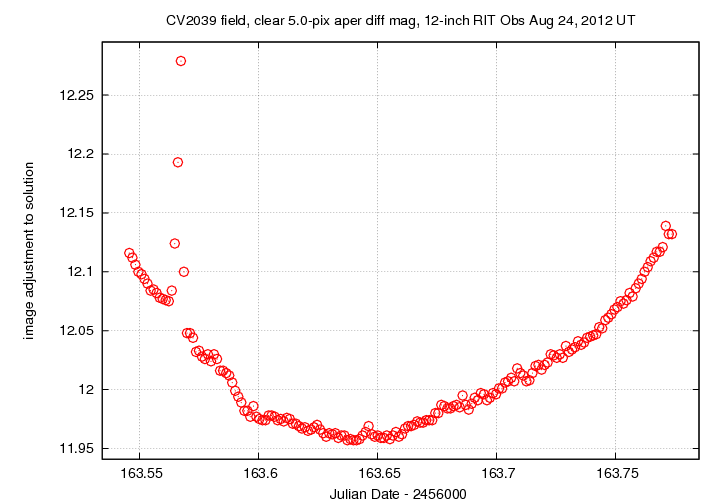
The scatter as a function of instrumental magnitude shows that the brightest unsaturated stars had a scatter of roughly 0.005 mag, while the target -- at instrumental mag 3.43 -- clearly varies significantly compared to other stars of similar brightness.
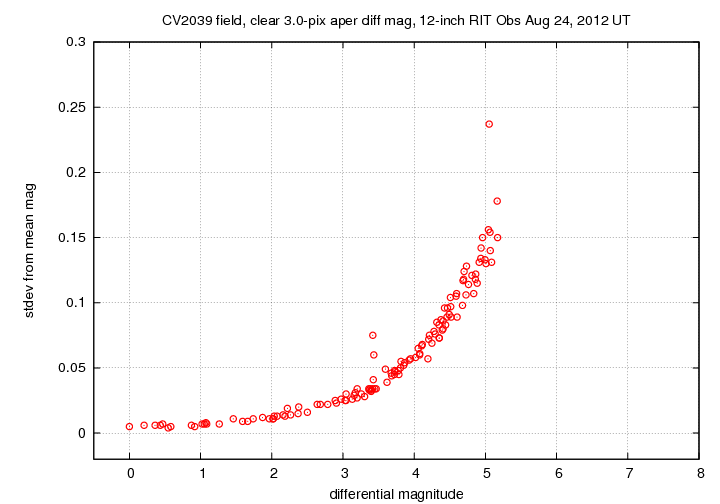
Here are light curves of the target star (green crosses) and some of the other stars in the field.
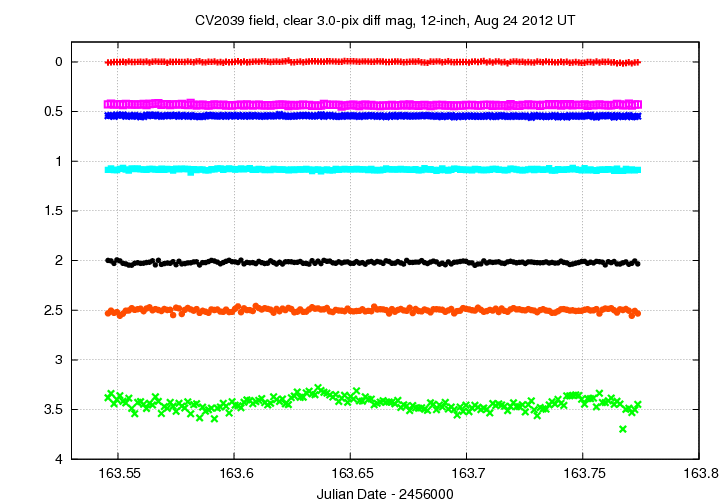
The target CSS203938-042908 goes through about two cycles during the observations.
I sent a message to cba-data with the following report. This shows only the first few lines of measurements -- the full set can be retrieved using the link below.
# Measurements of CSS203938-042908 made at RIT Obs, Aug 24, 2012 UT, # in good conditions, # by Michael Richmond, using 12-inch Meade and SBIG ST-8E CCD. # Exposures 90 seconds long, no filter. # Tabulated times are midexposure (FITS header time - half exposure length) # and accurate only to +/- 1 second (??). # 'mag' is a differential magnitude based on ensemble photometry # using a circular aperture of radius 5.6 arcseconds. # which has been shifted so AUID 000-BKQ-175 has mag=13.072 # which is its V-band magnitude according to AAVSO. # # UT_day JD HJD mag uncert Aug24.04576 2456163.54576 2456163.55110 15.910 0.036 Aug24.04704 2456163.54704 2456163.55238 15.867 0.036 Aug24.04832 2456163.54832 2456163.55366 15.969 0.040
I have sent this data to the Center for Backyard Astrophysics and vsnet-campaign-dn@ooruri.kusastro.kyoto-u.ac.jp via E-mail.
Just for fun, I co-added all 180 images taken on this night, using a median technique. Each image had an exposure time of 90 seconds, so the combination has an effective exposure time of 16,200 seconds = 4.5 hours. Here's the central portion of my unfiltered image, taken with a 12-inch telescope from the light-polluted skies of Rochester on the left; and a corresponding portion of the Digitized Sky Survey image, taken by a 48-inch Schmidt telescope and blue-sensitive J-plate at the Siding Spring Observatory. The faintest objects visible in the J-band image are roughly B=20 R=19.
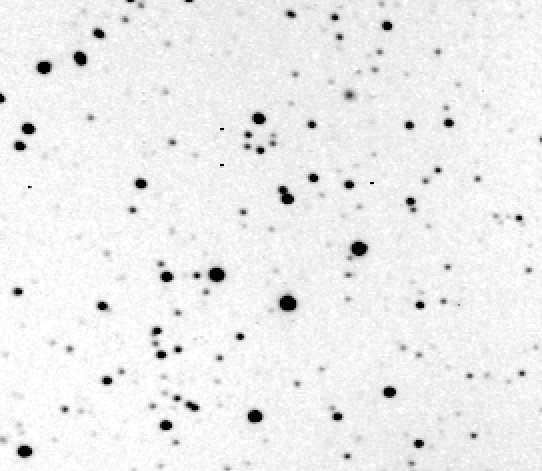
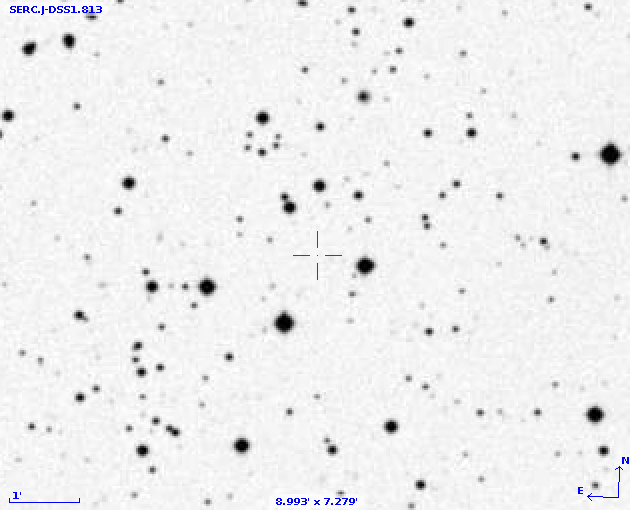
Last modified 08/24/2012 by MWR.